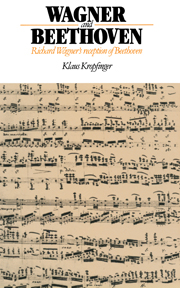Book contents
- Frontmatter
- Contents
- Preface
- Additional acknowledgements
- German and English abbreviations
- 1 Introduction
- 2 Wagner's experience of Beethoven
- 3 The Romantic background and Beethoven biography
- 4 Beethoven's role in Wagner's writings on art
- 5 Wagner's theory and construction of music drama
- 6 Wagner as Beethoven's heir
- Notes
- Bibliography
- Index of names
- Index of subjects
5 - Wagner's theory and construction of music drama
Published online by Cambridge University Press: 21 May 2010
- Frontmatter
- Contents
- Preface
- Additional acknowledgements
- German and English abbreviations
- 1 Introduction
- 2 Wagner's experience of Beethoven
- 3 The Romantic background and Beethoven biography
- 4 Beethoven's role in Wagner's writings on art
- 5 Wagner's theory and construction of music drama
- 6 Wagner as Beethoven's heir
- Notes
- Bibliography
- Index of names
- Index of subjects
Summary
The theory
Opposed critical viewpoints
One of the particular difficulties of studying the arts is that of tracing an artist's ideas in his works. We must first have a clear picture not only of the theory but also of the relationship between theory and practice. It was basically for want of this that inapposite judgments were passed on Wagner's works right from the beginning. At the time of his Zurich writings on artistic questions, critical discussion was already being determined by the mistaken idea that in Opera and Drama, Wagner wanted to sum up in theoretical terms what he had previously achieved as a composer–dramatist in Tannhäser and Lohengrin. In actual fact, Opera and Drama was influenced by the works Wagner had in view as much as by his past projects. (To his credit, Raff observed in 1854 that the Dresden works could not be judged by the standards of Opera and Drama.) In trying to map out in his head the new works he vaguely envisaged, the composer would draw on the experience of previous works and at the same time distance himself from them. It follows from this that as a creative artist, Wagner did not, indeed could not, adhere rigidly to his theoretical precepts – and that goes not only for Opera and Drama. But the compositional statement is often hard to fathom from an aesthetic viewpoint; this is probably the biggest methodical problem.
- Type
- Chapter
- Information
- Wagner and BeethovenRichard Wagner's Reception of Beethoven, pp. 155 - 242Publisher: Cambridge University PressPrint publication year: 1991



